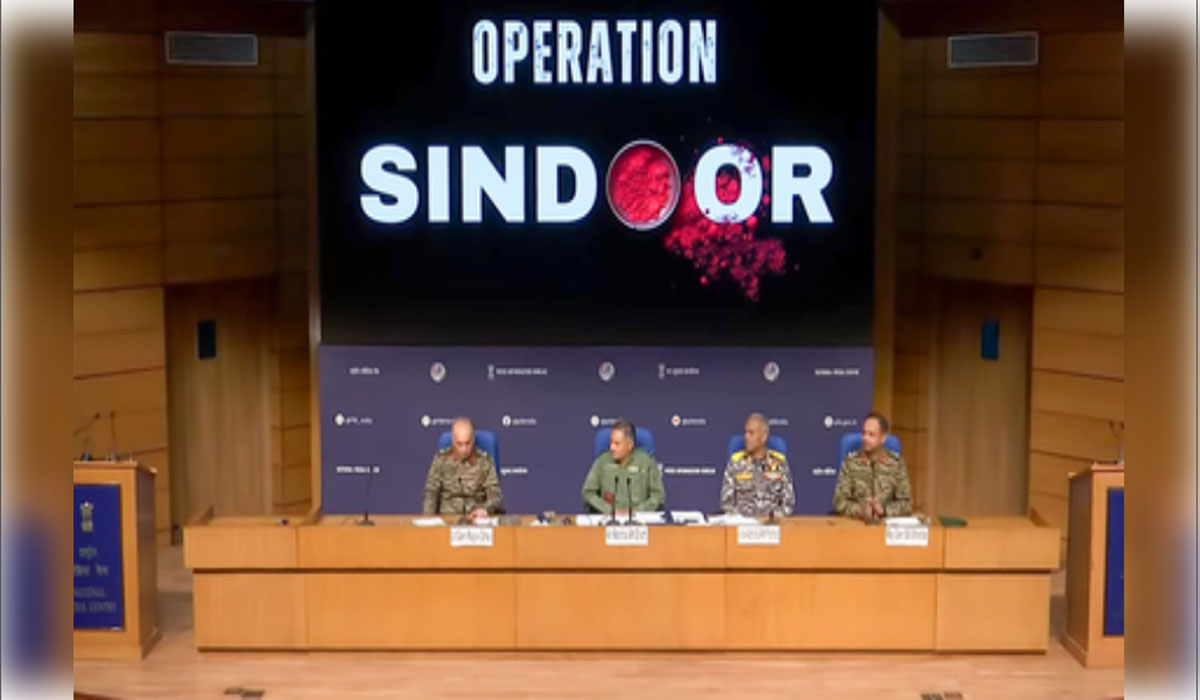
New Delhi, May 12: India on Monday reiterated that Operation Sindoor was a targeted response against terrorism and its support infrastructure, lamenting that Pakistan chose to stand with terrorists rather than remain neutral, prompting a necessary military retaliation.
“We have also reiterated that our fight was against terrorism and their support infrastructure and not with the Pakistan military. However, it is a pity that the Pakistani military chose to intervene and that for terrorists, which compelled us to respond,” said Director of Air Operations Air Marshal A.K. Bharti, Director General Air Operations, during a joint DGMO press briefing.
He clarified that India’s strikes on May 7 targeted only terrorist hideouts, but Pakistan’s direct military support to the terrorists turned the situation into an avoidable confrontation.
“Whatever damage they suffered, they are solely responsible for it,” Air Marshal Bharti said, asserting that India’s defence systems “stood like a wall,” preventing enemy breaches. He highlighted the stellar performance of India’s indigenous air defence ecosystem, especially the Akash missile system, in intercepting and neutralising threats.
“Waves of drones and unmanned combat aerial vehicles employed by Pakistan were thwarted by indigenously developed soft and hard kill counter-UAS systems,” he added. Officials also confirmed that Chinese and Turkish-made drones and PL-15 missiles were intercepted before breaching Indian airspace. Lieutenant General Ghai shared video evidence of an Indian strike that created a crater at Pakistan’s Noor Khan airbase, while affirming that all Indian airfields remain fully functional and operational.
The synergy across India’s military services, the support of other security forces like the Border Security Force (BSF), and the backing of India’s 140 crore citizens were described as the backbone of the country’s robust response.
“Our battle-proven systems stood the test of time. The integrated, multi-layered air defence shield has become impregnable — thanks to the budgetary and policy support provided by the government over the past decade,” Air Marshal Bharti said. He affirmed that India’s focus remains firmly on combating terrorism, and that military action was forced upon the country only by Pakistan’s decision to shield those responsible for cross-border terror.
The budgetary and policy support provided by the government to the forces over the past decade helped build an impregnable air defence shield that helped repulse attacks by Pakistani forces, which was exhibited during India’s anti-terror ‘Operation Sindoor’, said the Director General of Military Operations (DGMO) in a press briefing on Monday.
All airbases and military bases are operational and ready for their next missions, said Air Marshal A.K. Bharti, dismissing misinformation attempts. “Our fight is with the terrorists and not with the Pakistani military or civilians,” he said. Director General of Military Operations Rajiv Ghai said the multi-layered counter-drone and air defence grid proved to be the decisive shield that foiled all Pakistan air attacks on the night of May 9 and 10.
The officials said during Operation Sindoor, the defence systems destroyed Chinese and Turkish-made drones and PL-15 missiles, preventing them from entering our airspace. Sharing videos of a crater created by Indian bombs and missiles at Pakistan’s Noor Khan airbase, Ghai said Indian airfields remain fully operational. “I want to praise the Border Security Force also, who complemented our efforts by joining our counter-armed response,” he said.
“There has been absolute synergy in the three services, and not only have we been supported by government agencies, but also the 140 crore people,” he said. “Our fight was against terror, and on May 7, we hit only terror hubs, but the Pakistani Army converted it into its own fight by supporting terrorists,” said Air Marshal Bharti.
He described the multi-layered and integrated air defence (AD) as an impregnable shield that foiled all attempts made by Pakistani forces, including Unmanned Combat Aerial Vehicles, to violate Indian airspace. The performances of the older battle-proven systems were stellar, in addition to the Akash system, he said.
Vice Admiral A.N. Pramod highlighted the Indian Navy’s pressure that deterred the Pakistani Navy and Air Force to keep away from Arabian Sea. Earlier in the day, Prime Minister Narendra Modi chaired a high-level meeting with top government functionaries, including Defence Minister Rajnath Singh, External Affairs Minister S. Jaishankar, and NSA Ajit Doval.
The meeting took place at the Prime Minister’s residence in the national capital. Defence Minister Rajnath Singh, Chief of Defence Staff General Anil Chauhan and all three service chiefs – General Upendra Dwivedi, Admiral Dinesh K. Tripathi and Air Chief Marshal Amar Preet Singh – attended the meeting.
Foreign Secretary Vikram Misri, Intelligence Bureau (IB) Director Tapan Deka, and Research and Analysis Wing (R&AW) chief Ravi Sinha were also in the meeting. The high-level meeting came two days after India and Pakistan arrived at an understanding for a ceasefire with a decision that the DGMOs of both sides would talk to each other on May 12.
The ceasefire was sought by Pakistan after facing massive airstrikes by the Indian Air Force that destroyed 11 of its airbases.
